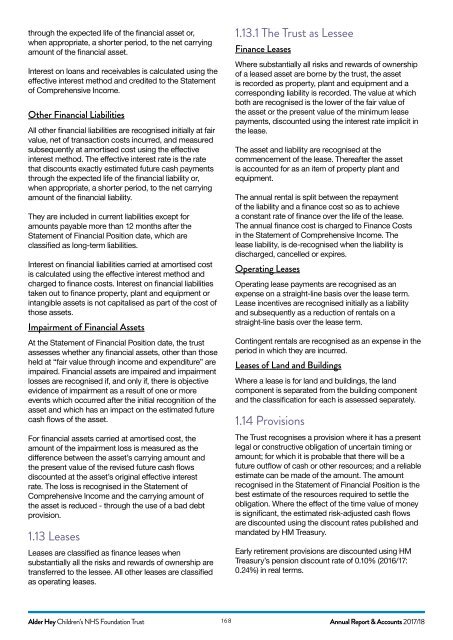AH ANNUAL REPORT 2018
Create successful ePaper yourself
Turn your PDF publications into a flip-book with our unique Google optimized e-Paper software.
through the expected life of the financial asset or,<br />
when appropriate, a shorter period, to the net carrying<br />
amount of the financial asset.<br />
Interest on loans and receivables is calculated using the<br />
effective interest method and credited to the Statement<br />
of Comprehensive Income.<br />
Other Financial Liabilities<br />
All other financial liabilities are recognised initially at fair<br />
value, net of transaction costs incurred, and measured<br />
subsequently at amortised cost using the effective<br />
interest method. The effective interest rate is the rate<br />
that discounts exactly estimated future cash payments<br />
through the expected life of the financial liability or,<br />
when appropriate, a shorter period, to the net carrying<br />
amount of the financial liability.<br />
They are included in current liabilities except for<br />
amounts payable more than 12 months after the<br />
Statement of Financial Position date, which are<br />
classified as long-term liabilities.<br />
Interest on financial liabilities carried at amortised cost<br />
is calculated using the effective interest method and<br />
charged to finance costs. Interest on financial liabilities<br />
taken out to finance property, plant and equipment or<br />
intangible assets is not capitalised as part of the cost of<br />
those assets.<br />
Impairment of Financial Assets<br />
At the Statement of Financial Position date, the trust<br />
assesses whether any financial assets, other than those<br />
held at “fair value through income and expenditure” are<br />
impaired. Financial assets are impaired and impairment<br />
losses are recognised if, and only if, there is objective<br />
evidence of impairment as a result of one or more<br />
events which occurred after the initial recognition of the<br />
asset and which has an impact on the estimated future<br />
cash flows of the asset.<br />
For financial assets carried at amortised cost, the<br />
amount of the impairment loss is measured as the<br />
difference between the asset’s carrying amount and<br />
the present value of the revised future cash flows<br />
discounted at the asset’s original effective interest<br />
rate. The loss is recognised in the Statement of<br />
Comprehensive Income and the carrying amount of<br />
the asset is reduced - through the use of a bad debt<br />
provision.<br />
1.13 Leases<br />
Leases are classified as finance leases when<br />
substantially all the risks and rewards of ownership are<br />
transferred to the lessee. All other leases are classified<br />
as operating leases.<br />
1.13.1 The Trust as Lessee<br />
Finance Leases<br />
Where substantially all risks and rewards of ownership<br />
of a leased asset are borne by the trust, the asset<br />
is recorded as property, plant and equipment and a<br />
corresponding liability is recorded. The value at which<br />
both are recognised is the lower of the fair value of<br />
the asset or the present value of the minimum lease<br />
payments, discounted using the interest rate implicit in<br />
the lease.<br />
The asset and liability are recognised at the<br />
commencement of the lease. Thereafter the asset<br />
is accounted for as an item of property plant and<br />
equipment.<br />
The annual rental is split between the repayment<br />
of the liability and a finance cost so as to achieve<br />
a constant rate of finance over the life of the lease.<br />
The annual finance cost is charged to Finance Costs<br />
in the Statement of Comprehensive Income. The<br />
lease liability, is de-recognised when the liability is<br />
discharged, cancelled or expires.<br />
Operating Leases<br />
Operating lease payments are recognised as an<br />
expense on a straight-line basis over the lease term.<br />
Lease incentives are recognised initially as a liability<br />
and subsequently as a reduction of rentals on a<br />
straight-line basis over the lease term.<br />
Contingent rentals are recognised as an expense in the<br />
period in which they are incurred.<br />
Leases of Land and Buildings<br />
Where a lease is for land and buildings, the land<br />
component is separated from the building component<br />
and the classification for each is assessed separately.<br />
1.14 Provisions<br />
The Trust recognises a provision where it has a present<br />
legal or constructive obligation of uncertain timing or<br />
amount; for which it is probable that there will be a<br />
future outflow of cash or other resources; and a reliable<br />
estimate can be made of the amount. The amount<br />
recognised in the Statement of Financial Position is the<br />
best estimate of the resources required to settle the<br />
obligation. Where the effect of the time value of money<br />
is significant, the estimated risk-adjusted cash flows<br />
are discounted using the discount rates published and<br />
mandated by HM Treasury.<br />
Early retirement provisions are discounted using HM<br />
Treasury’s pension discount rate of 0.10% (2016/17:<br />
0.24%) in real terms.<br />
Alder Hey Children’s NHS Foundation Trust 168<br />
Annual Report & Accounts 2017/18


